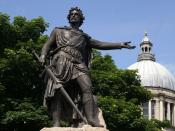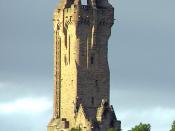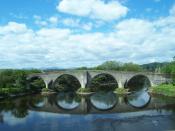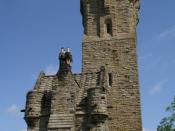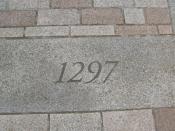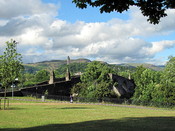William Wallace is one of Scotland's greatest national heroes, and leader of the Scottish resistance forces during the first years of the long and successful struggle to free Scotland from English rule at the end of the 13th Century. Records of Wallace's life are patchy and often inaccurate. This is partly because early accounts of his heroic deeds are speculative, and partly because he inspired such fear in the minds of English writers at the time. Wallace was born around 1270 in Scotland. He is said to have spent his childhood under the supervision of his uncle, who was a priest. Wallace probably led a comfortable and peaceful life as the son of a nobleman. By the time he was about sixteen, Wallace may have been preparing to pursue a life in the church. Scotland was essentially occupied by the English at this time, and was plagued by its own internal conflicts.
The Scottish nobles did little to maintain the rule of law and protect Scots.
William Wallace's father was killed in a skirmish with English troops in 1291. It is likely that the death of his father at the hands of the English contributed to Wallace's lifelong desire to fight for his nation's independence. However, little is known about Wallace's life during this period, except that he lived the life of an outlaw, moving constantly to avoid the English, and occasionally confronting them.
Edward marched north with his armies. After a five-month campaign, he conquered Scotland in 1297. Following his victory, he appointed his own agents to enforce peace in Scotland. He declared himself ruler of Scotland. Outside the south-east corner of Scotland, there was widespread disorder, and defiance against the English was increasing. Wallace was involved in a fight with local soldiers in the village of Ayr. After killing several of them, he was overpowered and thrown into a dungeon where he was slowly starved. Wallace was left for dead, but sympathetic villagers nursed him back to health. When he had regained his strength, Wallace recruited several local rebels and began his systematic and merciless assault on the hated English.
Although most of Scotland was in Scottish hands by August 1297, Wallace successfully recruited a band of commoners and small landowners to attack the remaining English garrisons. Wallace marched his forces towards Stirling Castle, a stronghold of vital strategic importance to the English. Although Wallace's forces were greatly outnumbered, they slaughtered the English. English fatalities are reported to have approached 5,000, gaining Wallace an overwhelming victory. He had shown not only that he was a charismatic leader and warrior, but also that his tactical military ability was strong. Never before had a Scottish army defeated an English aggressor so badly. Wallace captured Stirling Castle and for the moment Scotland was almost free of occupying forces.
Upon returning to Scotland early in December, he was knighted and proclaimed guardian of the kingdom. In less than six years, he had risen from obscurity to become Sir William Wallace, holder of one of the most powerful posts in the kingdom. Wallace's acclaim following the battle of Stirling Bridge was short-lived. Edward returned to England from campaigning in France in March 1298. He then invaded Scotland, intending to crush. Edward's 90,000-strong army attacked a much smaller Scottish force led by Wallace. The English army was at a technological advantage. Its longbow-men decimated Wallace's spearmen and cavalry by firing arrows over great distances. As many as 10,000 Scots may have been killed. Wallace's military reputation was ruined. He retreated to the thick woods nearby and resigned his guardianship. He was succeeded as guardian of the kingdom by Robert de Bruce.
Wallace was later betrayed by a Scottish knight in service to the English king, and arrested. He was tried for the wartime murder of civilians. He was condemned as a traitor to the king even though he had never sworn allegiance to Edward. At that time the punishment for the crime of treason was that the convicted traitor was dragged to the place of execution, hanged by the neck (but not until he was dead), and disembowelled while still alive. His entrails were burned before his eyes, he was decapitated and his body was divided into four parts. Accordingly, this was Wallace's fate. His head was impaled on a spike and displayed at London Bridge, his right arm on the bridge at Newcastle-upon-Tyne, his left arm at Berwick, his right leg at Perth, and the left leg at Aberdeen. By executing Wallace so barbarically, Edward had martyred a popular Scots military leader and fired the Scottish people's determination to be free. Almost immediately, Robert de Bruce revived the national rebellion that was to win independence for Scotland. He succeeded, and was crowned king of Scotland in 1306.
